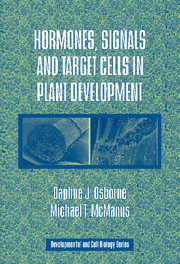Book contents
- Frontmatter
- Contents
- Preface
- 1 Introduction
- 2 Hormones and Signals: Identification and Description of Signalling Molecules
- 3 Cell-to-Cell Signalling: Short and Long Distance
- 4 Population Diversity of Cell Types and Target Identification in Higher Plants
- 5 Flexibility of Cell Types and the Target Cell Status
- 6 Terminally Committed Cell Types and the Target Status
- 7 The Mechanisms of Target Cell Perception and Response to Specific Signals
- 8 Hormone Action and the Relief of Repression
- 9 The Phenomenon of Hormonal Cross-Talk
- References
- Index
5 - Flexibility of Cell Types and the Target Cell Status
Published online by Cambridge University Press: 06 August 2009
- Frontmatter
- Contents
- Preface
- 1 Introduction
- 2 Hormones and Signals: Identification and Description of Signalling Molecules
- 3 Cell-to-Cell Signalling: Short and Long Distance
- 4 Population Diversity of Cell Types and Target Identification in Higher Plants
- 5 Flexibility of Cell Types and the Target Cell Status
- 6 Terminally Committed Cell Types and the Target Status
- 7 The Mechanisms of Target Cell Perception and Response to Specific Signals
- 8 Hormone Action and the Relief of Repression
- 9 The Phenomenon of Hormonal Cross-Talk
- References
- Index
Summary
Every cell can be considered a target cell, with a status that is subject to change throughout its life until a state of terminal differentiation is reached. On this basis, every cell is slightly different from its neighbour with respect to position and signal response, so that at any one time each cell has a unique target status even though it is a member of an apparently uniform tissue. Although the number of signals that have been identified or described so far are limited, the number of responding target cell types in plants would appear to be unlimited.
The flexibility of an individual cell, or perhaps more correctly, the flexibility of a group of cells to give rise by repeated cell divisions to a whole new plant, is the basis of the concept that plant cells remain totipotent throughout their lives. Horticulturists have used this knowledge in vegetative reproduction following observations that many isolated plant parts will readily regenerate new individuals with all the anatomical and behavioural characters of the parent. Planting a cutting is one thing, where all the coordinating signals and target cells are, as it were, still in operational position. Propagation by pieces of tissue where lines of intertissue communication have been lost is quite another.
The question of how a community of cell types in a callus or suspension culture develops in an organised and temporal fashion into a meristem is essentially unresolved though certain clues give consistency to the concept that specific short-distance signals are operating between them.
- Type
- Chapter
- Information
- Hormones, Signals and Target Cells in Plant Development , pp. 98 - 116Publisher: Cambridge University PressPrint publication year: 2005



